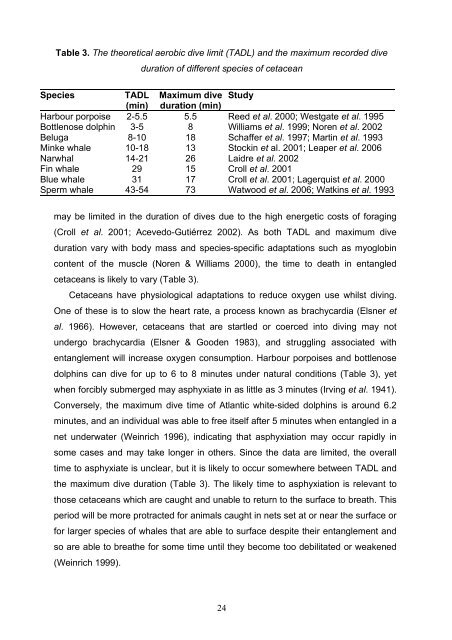The Animal Welfare Implications of Cetacean Deaths in Fisheries
The Animal Welfare Implications of Cetacean Deaths in Fisheries
The Animal Welfare Implications of Cetacean Deaths in Fisheries
Create successful ePaper yourself
Turn your PDF publications into a flip-book with our unique Google optimized e-Paper software.
Table 3. <strong>The</strong> theoretical aerobic dive limit (TADL) and the maximum recorded dive<br />
duration <strong>of</strong> different species <strong>of</strong> cetacean<br />
Species<br />
TADL Maximum dive Study<br />
(m<strong>in</strong>) duration (m<strong>in</strong>)<br />
Harbour porpoise 2-5.5 5.5 Reed et al. 2000; Westgate et al. 1995<br />
Bottlenose dolph<strong>in</strong> 3-5 8 Williams et al. 1999; Noren et al. 2002<br />
Beluga 8-10 18 Schaffer et al. 1997; Mart<strong>in</strong> et al. 1993<br />
M<strong>in</strong>ke whale 10-18 13 Stock<strong>in</strong> et al. 2001; Leaper et al. 2006<br />
Narwhal 14-21 26 Laidre et al. 2002<br />
F<strong>in</strong> whale 29 15 Croll et al. 2001<br />
Blue whale 31 17 Croll et al. 2001; Lagerquist et al. 2000<br />
Sperm whale 43-54 73 Watwood et al. 2006; Watk<strong>in</strong>s et al. 1993<br />
may be limited <strong>in</strong> the duration <strong>of</strong> dives due to the high energetic costs <strong>of</strong> forag<strong>in</strong>g<br />
(Croll et al. 2001; Acevedo-Gutiérrez 2002). As both TADL and maximum dive<br />
duration vary with body mass and species-specific adaptations such as myoglob<strong>in</strong><br />
content <strong>of</strong> the muscle (Noren & Williams 2000), the time to death <strong>in</strong> entangled<br />
cetaceans is likely to vary (Table 3).<br />
<strong>Cetacean</strong>s have physiological adaptations to reduce oxygen use whilst div<strong>in</strong>g.<br />
One <strong>of</strong> these is to slow the heart rate, a process known as brachycardia (Elsner et<br />
al. 1966). However, cetaceans that are startled or coerced <strong>in</strong>to div<strong>in</strong>g may not<br />
undergo brachycardia (Elsner & Gooden 1983), and struggl<strong>in</strong>g associated with<br />
entanglement will <strong>in</strong>crease oxygen consumption. Harbour porpoises and bottlenose<br />
dolph<strong>in</strong>s can dive for up to 6 to 8 m<strong>in</strong>utes under natural conditions (Table 3), yet<br />
when forcibly submerged may asphyxiate <strong>in</strong> as little as 3 m<strong>in</strong>utes (Irv<strong>in</strong>g et al. 1941).<br />
Conversely, the maximum dive time <strong>of</strong> Atlantic white-sided dolph<strong>in</strong>s is around 6.2<br />
m<strong>in</strong>utes, and an <strong>in</strong>dividual was able to free itself after 5 m<strong>in</strong>utes when entangled <strong>in</strong> a<br />
net underwater (We<strong>in</strong>rich 1996), <strong>in</strong>dicat<strong>in</strong>g that asphyxiation may occur rapidly <strong>in</strong><br />
some cases and may take longer <strong>in</strong> others. S<strong>in</strong>ce the data are limited, the overall<br />
time to asphyxiate is unclear, but it is likely to occur somewhere between TADL and<br />
the maximum dive duration (Table 3). <strong>The</strong> likely time to asphyxiation is relevant to<br />
those cetaceans which are caught and unable to return to the surface to breath. This<br />
period will be more protracted for animals caught <strong>in</strong> nets set at or near the surface or<br />
for larger species <strong>of</strong> whales that are able to surface despite their entanglement and<br />
so are able to breathe for some time until they become too debilitated or weakened<br />
(We<strong>in</strong>rich 1999).<br />
24
















